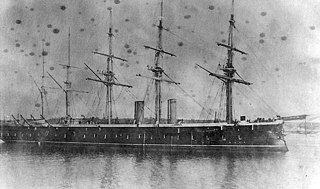 W
WHMS Agincourt was a Minotaur-class armoured frigate built for the Royal Navy during the 1860s. She spent most of her career as the flagship of the Channel Squadron's second-in-command. During the Russo-Turkish War of 1877–78, she was one of the ironclads sent to Constantinople to forestall a Russian occupation of the Ottoman capital. Agincourt participated in Queen Victoria's Golden Jubilee Fleet Review in 1887. The ship was placed in reserve two years later and served as a training ship from 1893 to 1909. That year she was converted into a coal hulk and renamed as C.109. Agincourt served at Sheerness until sold for scrap in 1960.
 W
WHMS Benbow was a 74-gun third rate ship of the line of the Royal Navy, built by Brent of Rotherhithe and launched on 3 February 1813.
 W
WThe Blue Jacket was an 1854 medium clipper well known for the lavish decoration of the staterooms and saloon. She served in the Liverpool and Australia trades. The ship was named after the blue jackets, a traditional name for sailors in the US and British navies.
 W
WCassard was an improved Téméraire class 74-gun ship of the line of the French Navy. Along with her sister-ship Vétéran, she carried 24-pounder long guns on her upper deck, a featured normally reserved for the larger, three-deckers capital ships or for 80-gun ships.
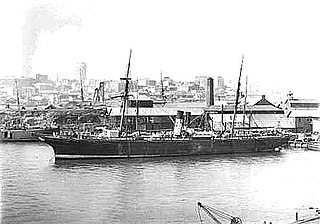 W
WThe City of Adelaide was a passenger steam ship launched during 1863 from Glasgow, Scotland. The vessel was later converted to a barque for use as a cargo transport. In 1912 the vessel was gutted by fire, and in 1916 the burnt hulk was run aground in Cockle Bay, Magnetic Island, Australia. During the Second World War four people were killed in a training accident when a RAAF aircraft struck the masts of the vessel.
 W
WClorinde was a 40-gun Pallas-class frigate of the French Navy, designed by Sané. The British Royal Navy captured her in 1814 and renamed her HMS Aurora. After 19 years as a coal hulk she was broken up in 1851.
 W
WHMS Enterprise was an Arctic discovery ship laid down as a merchant vessel and purchased in 1848 before launch to search for Sir John Franklin's lost expedition. She made two Arctic voyages before becoming a coal depot, and was finally sold in 1903. She was the tenth Enterprise to serve in the Royal Navy.
 W
WThe CS Faraday was a cable ship built for Siemens Brothers and launched in 1874.
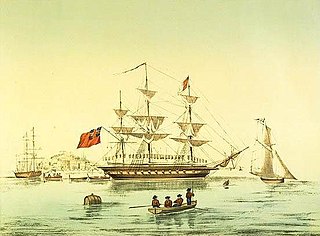 W
WHMS Fly was an 18-gun sloop of the Royal Navy. She was responsible for the exploration and charting of much of Australia's north-east coast and nearby islands. She was converted to a coal hulk in 1855 and broken up in 1903.
 W
WSMS Friedrich der Grosse was an ironclad turret ship built for the German Kaiserliche Marine. She was the second of three Preussen-class ironclads, in addition to her two sister-ships Preussen and Grosser Kurfürst. Named for Frederick the Great, she was laid down at the Imperial Dockyard in Kiel in 1871 and completed in 1877. Her main battery of four 26 cm (10 in) guns was mounted pair of twin gun turrets amidships.
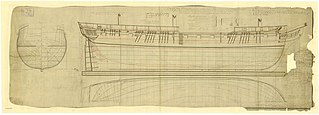 W
WHMS Galatea was an Apollo-class fifth rate of the Royal Navy. The frigate was built at Deptford Dockyard, London, England and launched on 31 August 1810. In 1811 she participated in the Battle of Tamatave, which battle confirmed British dominance of the seas east of the Cape of Good Hope for the rest of the Napoleonic Wars. She was hulked in 1836 and broken up in 1849.
 W
WSS Great Britain is a museum ship and former passenger steamship, which was advanced for her time. She was the longest passenger ship in the world from 1845 to 1854. She was designed by Isambard Kingdom Brunel (1806–1859), for the Great Western Steamship Company's transatlantic service between Bristol and New York City. While other ships had been built of iron or equipped with a screw propeller, Great Britain was the first to combine these features in a large ocean-going ship. She was the first iron steamer to cross the Atlantic Ocean, which she did in 1845, in the time of 14 days.
 W
WHMS Hastings was a 74-gun third rate ship of the line of the Royal Navy. She was built in Calcutta for the Honourable East India Company, but the Royal Navy purchased her in 1819. The Navy sold her in 1886.
 W
WHMS Himalaya was built for the Peninsular and Oriental Steam Navigation Company as SS Himalaya, a 3,438 gross register ton iron steam screw passenger ship. She was purchased by the Royal Navy in 1854 for use as a troopship until 1894 and was then moored in the Hamoaze, Devonport to serve as a Navy coal hulk until 1920, when sold off. She was sunk during a German air attack on Portland Harbour in 1940.
 W
WHMS Hyacinth was an 18-gun Royal Navy ship sloop. She was launched in 1829 and surveyed the north-eastern coast of Australia under Francis Price Blackwood during the mid-1830s. She took part in the First Opium War, destroying, with HMS Volage, 29 Chinese junks. She became a coal hulk at Portland in 1860 and was broken up in 1871.
 W
WHMS Implacable was a 74-gun third-rate ship of the line of the Royal Navy. She was originally the French Navy's Téméraire-class ship of the line Duguay-Trouin, launched in 1800.
 W
WThe USS Iosco was a 1173-ton Sassacus class "double-ender" steam gunboat built at Bath, Maine. The ship fought during the Civil War, and was an important combatant during the battles at Fort Fisher. The ship was named Iosco after a Native American word meaning "water of light," the namesake for Iosco County, Michigan.
 W
WHMS Iron Duke was the last of four Audacious-class central battery ironclads built for the Royal Navy in the late 1860s. Completed in 1871, the ship was briefly assigned to the Reserve Fleet as a guardship in Ireland, before she was sent out to the China Station as its flagship. Iron Duke returned four years later and resumed her duties as a guardship. She accidentally rammed and sank her sister ship, Vanguard, in a heavy fog in mid-1875 and returned to the Far East in 1878. The ship ran aground twice during this deployment and returned home in 1883. After a lengthy refit, Iron Duke was assigned to the Channel Fleet in 1885 and remained there until she again became a guardship in 1890. The ship was converted into a coal hulk a decade later and continued in that role until 1906 when she was sold for scrap and broken up.
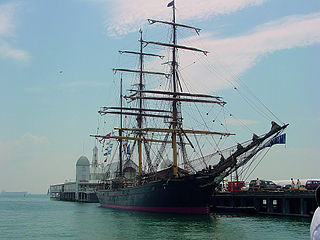 W
WJames Craig is a three-masted, iron-hulled barque restored and sailed by the Sydney Heritage Fleet, Sydney, Australia.
 W
WHMS Jumna was a Euphrates-class troopship launched at Palmers Shipbuilding and Iron Company at Hebburn on 24 September 1866. She was the third vessel of the Royal Navy to carry the name.
 W
WLady Elizabeth is a wrecked iron barque of 1,155 tons built by Robert Thompson Jr. of Southwick, Sunderland and launched on 4 June 1879. Robert Thompson Jr. was one of the sons of Robert Thompson Sr. who owned and operated the family ran shipyard J. L. Thompson & Sons. Thompson Jr. eventually left the family business in 1854 to start his own shipbuilding business in Southwick, Sunderland. The ship was built for John Wilson as a replacement for the 658-ton, 1869-built barque Lady Elizabeth which sank off Rottnest Island, Western Australia in 1878.
 W
WThe Lagoda is a half-scale model of the whaling ship Lagoda, located at the New Bedford Whaling Museum. The original ship was built in 1826, converted to a whaling ship in 1841, and broken up in 1899. The model was commissioned in 1916 and is the world's largest whaling ship model.
 W
WLarkins made ten voyages for the British East India Company (EIC), all as an "extra ship", i.e. under contract. On two of these voyages she first transported convicts to Australia. She also made one convict voyage independently of the EIC. She traded extensively between England and India or China, and in this twice suffered serious but not fatal maritime mishaps. In 1853 she became a coal hulk at Albany, Western Australia, and remained there until she was broken up in 1876.
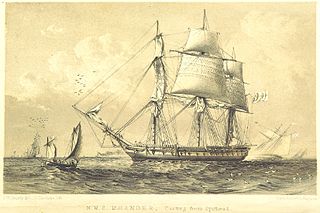 W
WHMS Maeander was a Seringapatam-class sailing frigate of the British Royal Navy. Her service included the suppression of piracy, the Russian War, and support for the suppression of slavery with the West Africa Squadron. She was wrecked in a gale in 1870.
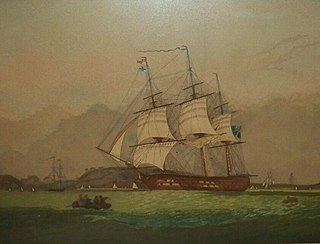 W
WHMS Malabar was a 74-gun third-rate ship of the line of the Royal Navy, launched on 28 December 1818 at Bombay Dockyard.
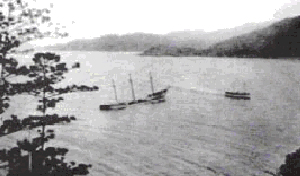 W
WThe Moltke was a three-masted barque built in Hamburg, Germany in 1870. The vessel was wrecked off the coast of northern Queensland, Australia in 1890 before being refloated and hulked. In 1911 the vessel was scuttled off Geoffrey Bay, Magnetic Island. The wreck of the vessel now hosts a wide range of underwater life and is a popular open-water dive site.
 W
WHMS Nelson was a 126-gun first rate ship of the line of the Royal Navy, launched on 4 July 1814 at Woolwich Dockyard, but then laid up incomplete at Portsmouth until 1854, when work began with a view to commissioning her for service in the Crimean War, but this ended before much work had been done, and the ship returned to reserve.
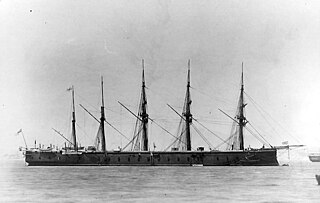 W
WHMS Northumberland was the last of the three Minotaur-class armoured frigates built for the Royal Navy during the 1860s. She had a different armour scheme and heavier armament than her sister ships, and was generally regarded as a half-sister to the other ships of the class. The ship spent her career with the Channel Squadron and occasionally served as a flagship. Northumberland was placed in reserve in 1890 and became a training ship in 1898. She was converted into a coal hulk in 1909 and sold in 1927, although the ship was not scrapped until 1935.
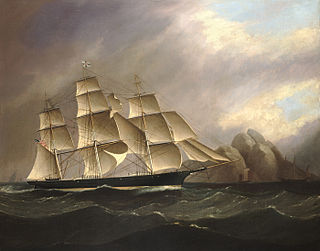 W
WOcean Telegraph was an American clipper ship. Built in 1854 for the run between New York and San Francisco, she was sold to a British firm in 1863 and renamed Light Brigade. For the next 12 years she was used predominantly to transport cargo and immigrants between London and Australia and New Zealand.
 W
WPolly Woodside is a Belfast-built, three-masted, iron-hulled barque, preserved in Melbourne, Victoria (Australia), and forming the central feature of the South Wharf precinct. The ship was originally built in Belfast by William J. Woodside and was launched in 1885. Polly Woodside is typical of thousands of smaller iron barques built in the last days of sail, intended for deep water trade around the world and designed to be operated as economically as possible.
 W
WSMS Preussen was an ironclad turret ship built for the German Kaiserliche Marine. The ship was built by the AG Vulcan shipyard in Stettin in 1871–1876; she was commissioned into the fleet in July 1876. She was the first large warship of the German navy built by a private shipyard; all previous vessels had been ordered abroad or built by Royal or Imperial dockyards. Her main battery of four 26 cm (10.2 in) guns was mounted in a pair of twin gun turrets amidships.
 W
WRed Jacket was a clipper ship, one of the largest and fastest ever built. She was also the first ship of the White Star Line company. She was named after Sagoyewatha, a famous Seneca Indian chief, called "Red Jacket" by settlers. She was designed by Samuel Hartt Pook, built by George Thomas in Rockland, Maine, and launched in 1853, the last ship to be launched from this yard.
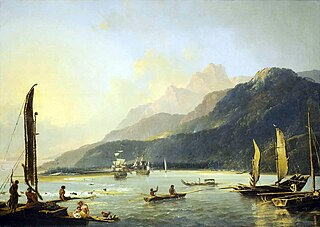 W
WHMS Resolution was a sloop of the Royal Navy, a converted merchant collier purchased by the Navy and adapted, in which Captain James Cook made his second and third voyages of exploration in the Pacific. She impressed him enough that he called her "the ship of my choice", and "the fittest for service of any I have seen".
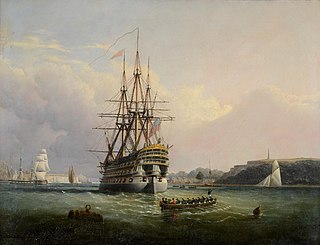 W
WHMS Royal Adelaide was a 104-gun first-rate ship of the line of the Royal Navy, launched on 28 July 1828 at Plymouth.
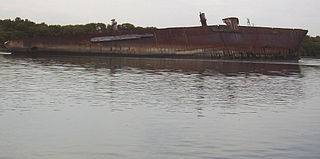 W
WThe Santiago was a 455-ton barque launched in 1856. It was built by Henry Balfour of Methil, Fife for the Liverpool shipping company Balfour Williamson. It sailed mainly between Liverpool and Chile, but also to Australia. Its remnant hull, which lies in a ships' graveyard in South Australia, is considered 'the oldest intact iron hull sailing vessel in the world.'
 W
WHMS Sparrow was a Redbreast-class gunboat launched in 1889, the sixth Royal Navy ship to bear the name. She became the New Zealand training ship NZS Amokura in 1906 and was sold in 1922.
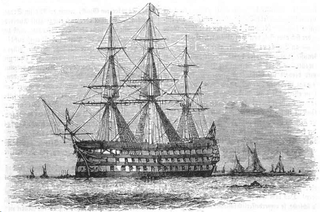 W
WHMS Trafalgar was ordered as a 98-gun second-rate ship of the line, re-rated as a 106-gun first-rate ship of the line in February 1817 and launched on 26 July 1820 at Chatham. She was jointly designed by the Surveyors of the Navy at the time, and was the only ship built to her draught.
 W
WUSS Vanderbilt was a heavy (3,360-ton) passenger steamship obtained by the Union Navy during the second year of the American Civil War and utilized as a cruiser.
 W
WSS Westralia was a 2,884 GRT cargo and passenger ship. She served as a troopship in World War I and was later converted into a hulk. She was sunk in the air raids on Rabaul on 20 January 1942.
 W
WThe Young America was built by William H. Webb of New York. She was launched in 1853, at the height of the clipper construction boom. She sailed in the California trade, on transatlantic routes, and made voyages to Australia and the Far East.